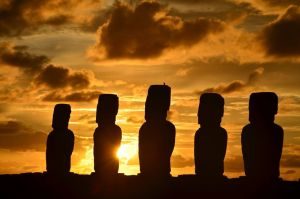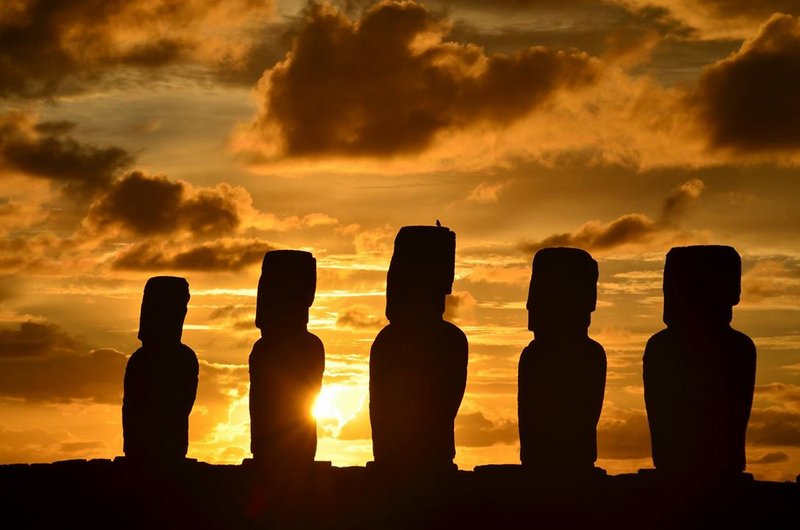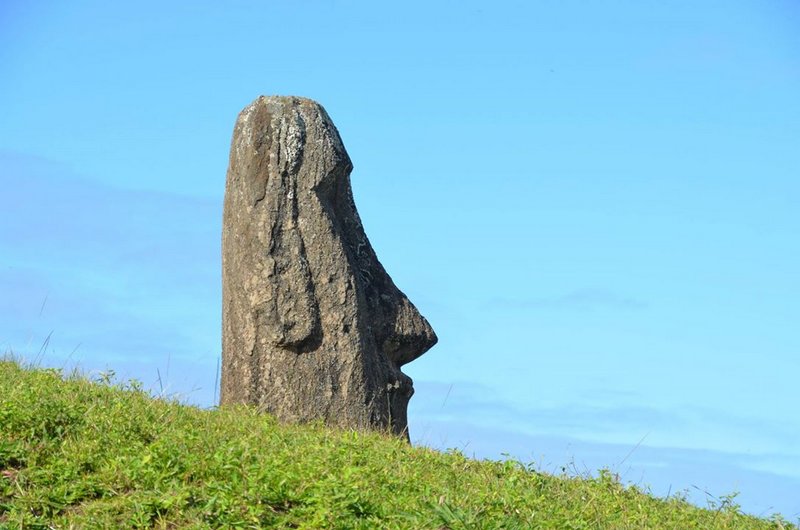
Hundreds of years before Dutch commander Jakob Roggeveen and his ships arrived at Easter Island in the Pacific in 1722, the native Rapa Nui islanders had already made contact with South Americans.
So suggests an international team of researchers led by Anna-Sapfo Malaspinas and Eske Willerslev of the Natural History Museum of Denmark’s Centre for GeoGenetics, who analyzed genome-wide data for 27 Rapa Nui individuals. While they detected mostly Polynesian ancestry, they also found “genome-wide patterns consistent with Native American and European admixture”, and that the “Native American admixture occurred before the European admixture.” By comparing their data with other data set proportions, they determined that the Native American proportion was significantly greater than that detected in other Polynesians and Europeans. Moreover, “by considering the distribution of local ancestry tracts of eight unrelated Rapa Nui, we found statistical support for Native American admixture dating to AD 1280 – 1495 and European admixture dating to AD 1850 – 1895.”* The research study is published in the Cell Press journal, Current Biology.
The results are consistent with other archaeological evidence that suggests contact, such as the finding that crops that were native to the Americas existed in Polynesia, including the Andean sweet potato, long before European contact. The results of another study (also published in Current Biology) by Malaspinas and Eske Willerslev and their colleagues, wherein they examined two human skulls of the indigenous “Botocudos” of Brazil, found that their genomic ancestry is Polynesian, with no detectable Native American component.
“These genetic results,” report the researchers in their published study, “can be explained by one or more pre-European trans-Pacific contacts.”*
Easter Island,a Polynesian island in the southeastern Pacific Ocean, is well-known for its monumental statues called moai, created by the early Rapa Nui people. Archaeological evidence shows that Polynesian people settled on Easter Island in the first millennium AD and developed a sustained civilization there. But the Rapa Nui significantly declined due to the introduction of the Polynesian rat, and overpopulation led to gradual deforestation and extinction of natural resources, leading to the demise of its civilization.
______________________________________
 Above and below: The Rapanui are best known for building giant stone platforms and statues. Courtesy Natalia Solar
Above and below: The Rapanui are best known for building giant stone platforms and statues. Courtesy Natalia Solar
______________________________________
 _________________________________________________
_________________________________________________
Archaeological studies and evidence has shown that the Polynesians had the technological and knowledge capacity to execute long-range voyages across the Pacific, consistent with the time range results of the genetic study. This new evidence related to the Rapa Nui suggests one of two scenarios, according to the study authors: either Native Americans sailed to Rapa Nui or Polynesians sailed to the Americas and back. The researchers suggest that it was more likely that the Rapanui successfully made the trip back and forth, given simulations presented in previous studies showing that “all sailing voyages heading intentionally east from Rapa Nui would always reach the Americas, with a trip lasting from two weeks to approximately two months.” On the other hand, the trip from the Americas to Rapa Nui is much more challenging, given that Rapanui is a small target, making it likely to fail or miss the island completely.
For Malaspinas, the findings are a reminder that “early human populations extensively explored the planet. Textbook versions of human colonization events—the peopling of the Americas, for example—need to be re-evaluated utilizing genomic data.”
_________________________________________
* http://www.cell.com/current-biology/abstract/S0960-9822(14)01220-2
Also adapted and edited from a Cell Press news release.
_______________________________________________________
Travel and learn with Far Horizons.
Read about the most fascinating discoveries with a premium subscription to Popular Archaeology Magazine. Find out what Popular Archaeology Magazine is all about. AND MORE:
On the go? Get the smartphone version of Popular Archaeology as an app or as an ebook.
Popular Archaeology’s annual Discovery Edition eBook is a selection of the best stories published in Popular Archaeology Magazine in past issues, with an emphasis on some of the most significant, groundbreaking, or fascinating discoveries in the fields of archaeology and paleoanthropology and related fields. At least some of the articles have been updated or revised specifically for the Discovery edition. We can confidently say that there is no other single issue of an archaeology-related magazine, paper print or online, that contains as much major feature article content as this one. The latest issue, volume 2, has just been released. Go to the Discovery edition page for more information.







